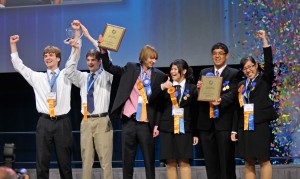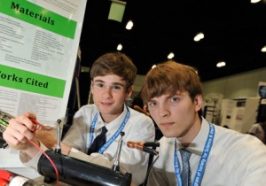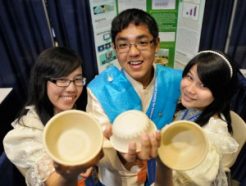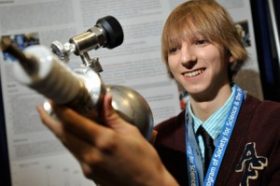Kids’ ingenuity honored at Intel ISEF
Young scientists receive awards in international competition

LOS ANGELES — Cancer-killing X-rays, nuclear threat detection and a fishy new plastic were behind the high school projects that took top awards at the 2011 Intel International Science and Engineering Fair, also known as ISEF. Collectively, hundreds of students took home more than $4 million in awards and prizes at a May 13 awards ceremony.
The weeklong science competition drew more than 1,500 students from all over the world to Los Angeles. Society for Science & the Public, or SSP, which is Science News for Kids’ parent organization, runs Intel ISEF.
“Congratulations to each one of you,” SSP president Elizabeth Marincola told the finalists. “Your innovation will help our global community transition to sustainable energy sources, mitigate the impact of national disasters and lead to new ways of preventing and treating addictions and disease.”
The top prize of $75,000, the Gordon E. Moore Award (named for the Intel Corporation cofounder and inventor of the famous Moore’s Law, which predicts how fast computers improve), went to two California high school seniors who invented a way to fry cancer cells. Matthew Feddersen, 17, and Blake Marggraff, 18, of Lafayette, Calif., injected tiny particles of tin into globs of yeast cells, which served as tumor stand-ins. When the globs were hit with X-rays, the tin scattered this radiation, which killed more cells than the initial X-rays alone. In tests, the tin didn’t seem to have any toxic effects. “It’s like a chemotherapy drug without the side effects,” Marggraff explained.

Feddersen says the two got the idea from news reports about faulty tin-based shields that were harming workers at nuclear power plants. These shields were producing the same kind of radiation that the team used in its project.
The technique could easily work with X-ray machines, such as those that take pictures of teeth in dental offices, say Feddersen and Marggraff, both of whom have had family members with cancer. What’s more, the total treatment would cost about 60 cents per patient, so the technique could offer a powerful and affordable way to fight cancer in places where people don’t have access to fancy medical equipment.
Next year, Marggraff plans to attend Washington University in St. Louis, and Feddersen plans to go to the University of Illinois at Urbana-Champaign. Just after the awards ceremony, the two top winners were stunned to hear their names called. “It’s amazing. I don’t know how to describe it,” said Feddersen. “We were disappointed when we didn’t get fourth,” he said, so learning that they were in fact the top winners “was astounding.”

Three students from Thailand won Intel’s Young Scientist Award, which comes with $50,000. The team designed a new type of plastic out of fish scales. Pornwasu Pongtheerawan, 16, of Muang; Tanpitcha Phongchaipaiboon, 17, of Meung district; and Arada Sungkanit, 17, also of Meung district, will split the award.
With an abundance of fish scales in Thailand, the team wondered whether a gelatinous product contained in the bony structures might be useful. After many experiments, the three hit upon a winning formula that produced firm, moldable plastics from the fish-scale gelatin. Bowls and plates made of the plastic decorated their booth at the fair (and the plasticware had no trace of fishy odor). If buried in soil, the plastic completely breaks down in about 28 days, the student scientists found. And it doesn’t seem to harm critters that live in the dirt. So far, the plastic isn’t able to hold hot water or go into the microwave, so the team is tweaking their recipe.
Another recipient of Intel’s Young Scientist Award — and $50,000 — is Taylor Wilson, 17, of Reno, Nev. Wilson created a sensitive, low-cost way to detect nuclear material such as weapons-grade plutonium and highly enriched uranium. At the heart of the detection method is Wilson’s fusion reactor, a machine he made that melds together tiny atoms of a special kind of heavy hydrogen, called deuterium, which, unlike normal hydrogen, contains a neutron in its nucleus. This process releases neutrons.

Wilson envisions shooting such neutrons into cargo containers, as might be found at seaports or trucking stations, and then observing what kind of radiation signatures are emitted for clues as to whether (and what kind of) nuclear material might be inside. Other nuclear detection methods rely on helium-3, a variant of normal helium atoms that is currently in short supply. Wilson’s instead relies on water — an abundant, cheap and nontoxic material. His method could be used to detect people smuggling dangerous radioactive material at border crossings or ports. This student’s work has already received funding from the U.S. Department of Homeland Security.
“It feels amazing,” Wilson said right after he won the award. “Science is really cool, and you can change the world.”
Two projects were awarded the Dudley R. Herschbach SIYSS Award, which stands for Stockholm International Youth Science Seminar. This prize comes with an all-expense-paid trip to Sweden to attend both the seminar and the Nobel Prize ceremonies. The award is named for Herschbach, who won a Nobel prize in chemistry in 1986. He is also emeritus board chair of Society for Science & the Public.
The first winning project comes from two South Korean students who created a material that mimics spider silk. They designed it to gather water. Like dew on spiderwebs, small drops of water glom onto the material. This creates bigger droplets, which then can be funneled into a reservoir. Jinyoung Seo, 18, of Go-Yang City and Dongju Shin, 18, of Seoul are currently building water-harvesting devices with the silk-mimicking material. These devices could be used to collect drinking water in places where there is fog but very little rain.
The second Herschbach SIYSS award went to Andrew Kim, 18, of Athens, Ga. In his project, Kim explored why some fruit flies are extreme fighters. They punch, head-butt and lunge at other flies. The more social experiences a male fly has had, the less likely he is to be aggressive, Kim found. A gene (called cyp6a20) seems to have a role in the process, too. Understanding what kinds of things in the brain make flies fight might help scientists figure out why some people are more likely to fight, Kim says.
“These kids are our future,” said Wendy Hawkins, executive director of the Intel Foundation. “They build the world that we are going to have to live and thrive in.” Seeing what they’ve accomplished “restores my hope that we’re all going to be OK,” she said.
In each of 17 categories, which ranged from Animal Sciences to Energy and Transportation, students won other prizes ranging from $5,000 to $500. First- and second-place winners in each category will also get a minor planet — otherwise known as an asteroid — named after them, courtesy of MIT’s Lincoln Laboratory. A program at the lab searches the sky for objects in Earth’s solar system, scouting for objects that could strike our planet. MIT’s Jenifer Brinker Evans assured the winners that their asteroids wouldn’t pose a threat: “No one has to fear their namesake will be the source of world destruction,” she said.